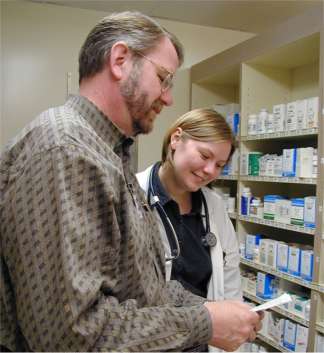|
Tom
Larson, PhD |
 |
PHARMACY
|
Tom
Larson, PhD |
 |
The profession of pharmacy has evolved from a strictly compounding and dispensing focus to include the provision of pharmaceutical care in the 1990's. Presently five models exist that embody the practice of pharmacy: distributive, drug information, self-care, clinical pharmacy and pharmaceutical care.
|

|
|
A representation of skills required to work within each model: Distributive:
Drug
Information: Self-Care:
Provide general advice to health care consumers in individual settings,
and assess individual's needs.
Clinical Pharmacy: To contribute to the physician's therapeutic management of a patient by providing a service such as, drug information, pharmacokinetic dosing, or drug history. Pharmaceutical
Care: Reference: Holland RW, Nimmo CM. Transitions, part 1: Beyond pharmaceutical care. AM J Health-Syst Pharm. 1999; 56:1758-64.
|
| Pharmacist instructing patient on a new device for measuring blood glucose levels. |
Since 1995, all entering students at the University of Minnesota have enrolled in a program leading to the doctor of pharmacy degree (PharmD). The PharmD is a professional program involving four years of study after a minimum of two years of general college education. The bachelor's degree in pharmacy was eliminated to ensure that students receive a strong scientific grounding in drugs and diseases and extensive training in primary care pharmacy. All students now practice clinical skills in a state of the art pharmaceutical care laboratory that integrates the theory and practice of pharmaceutical care. The University of Minnesota graduates 100 students per year from the only accredited college in the State. Approximately 50% of new graduates become employed in community and hospital pharmacies, 25% pursue advanced residencies and fellowships and 25% work in the pharmaceutical industry, pharmacy benefit management organizations or nontraditional pharmacy roles.
|
| Certification/Licensing |
Pharmacists must have graduated from an accredited school of pharmacy and passed state and national board exams. Pharmacists must be registered with the Minnesota Board of Pharmacy in order to practice. To maintain their license, pharmacists must complete 30 hours of continuing education every two years.
Upon successful completion of a written certification examination, pharmacists can be certified in pharmocotherapy, nutrition, cardiology, radiopharmaceuticals, geriatrics or infectious disease. Certification is not mandatory at this time.
| Special Potentials |
Identifying, resolving and preventing prescription and over-the-counter drug related problems
In collaboration with other providers, evaluate and manage pharmacotherapy
Serving as consultants to physicians and other health care professionals
Serving the traditional role of family friend and confidant
|
Related Links: |
![]() University
of Minnesota College of Pharmacy
University
of Minnesota College of Pharmacy
![]() NEWSLine
for Pharmacists
NEWSLine
for Pharmacists
![]() The
American Pharmacy Alliance
The
American Pharmacy Alliance
![]() National
Community Pharmacists Association
National
Community Pharmacists Association
![]() US
Pharmacist
US
Pharmacist
Back to Home
For questions, please contact Terry Estep.